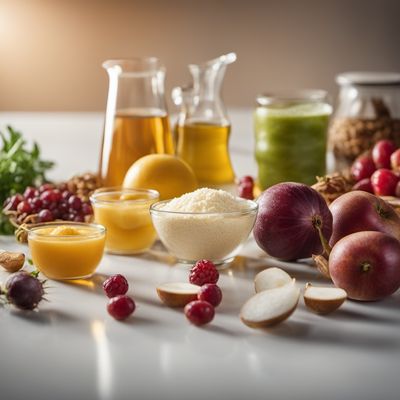
Ingredient
Binding agent
The Glue of Culinary Creations: Unveiling the Power of Binding Agents
Binding agents are substances used in cooking and baking to bring together ingredients and provide cohesion. They come in various forms, including liquids, powders, and gels, and each type has unique characteristics. Binding agents can be natural, such as eggs, gelatin, or starches like cornstarch and arrowroot, or synthetic, like xanthan gum or guar gum. These agents contribute to the texture, consistency, and stability of dishes, ensuring that ingredients stay together and create a harmonious final product. They can thicken sauces, emulsify dressings, stabilize ice creams, and bind ingredients in baking, making them indispensable in the culinary world.
Origins and history
The use of binding agents in cooking and baking dates back centuries. Eggs, one of the most common natural binding agents, have been used in culinary preparations since ancient times. Starches like cornstarch and arrowroot have been utilized for thickening and binding in Asian cuisines for centuries. The development of synthetic binding agents, such as xanthan gum and guar gum, emerged in the late 20th century as food science and technology advanced. These synthetic agents provided alternatives for individuals with dietary restrictions or preferences, expanding the possibilities in culinary creations.
Nutritional information
Binding agents vary in their nutritional composition. Natural binding agents like eggs provide protein, vitamins, and minerals, while starches like cornstarch and arrowroot are primarily carbohydrates. Synthetic binding agents like xanthan gum and guar gum are low in calories and do not contribute significant nutrients.
Allergens
Eggs, a common natural binding agent, are a known allergen. Individuals with egg allergies should avoid dishes containing eggs as a binding agent.
How to select
When selecting a binding agent, consider the specific requirements of your recipe. For thickening sauces or gravies, cornstarch or arrowroot can be used. Gelatin is ideal for setting desserts or creating jellies. Xanthan gum and guar gum are suitable for gluten-free or vegan recipes. Ensure that the binding agent is fresh and free from any clumps or lumps, as this can affect its performance.
Storage recommendations
Natural binding agents like eggs should be stored in the refrigerator to maintain freshness. Powders like cornstarch, arrowroot, xanthan gum, and guar gum should be stored in a cool, dry place away from moisture to prevent clumping. Follow the instructions on the packaging for specific storage recommendations.
How to produce
Binding agents like eggs or gelatin are typically produced through natural processes involving animals. However, synthetic binding agents like xanthan gum and guar gum are produced through industrial processes and are not easily replicated at home.
Preparation tips
When using binding agents, it is important to follow the recipe instructions carefully to achieve the desired results. For natural binding agents like eggs, ensure they are at room temperature before incorporating them into the recipe. When using starches as binding agents, mix them with a small amount of cold liquid before adding them to hot mixtures to prevent clumping. Experiment with different binding agents to understand their unique properties and how they affect the texture and consistency of your dishes.
Culinary uses
Binding agents are used in a wide range of culinary applications. Eggs are commonly used as binding agents in baking, such as in cakes, cookies, and bread. Gelatin is used to set desserts like panna cotta or aspic. Cornstarch and arrowroot are used to thicken sauces, gravies, and soups. Xanthan gum and guar gum are often used in gluten-free baking or as stabilizers in ice creams and dressings.
Availability
Binding agents like eggs, cornstarch, and gelatin are widely available in grocery stores and supermarkets worldwide. Synthetic binding agents like xanthan gum and guar gum can also be found in specialty food stores or online.
More ingredients from this category » Browse all

Emulsifier
The Harmony Enhancer

Propellent gas
The Power Behind the Spray: Unveiling the Secrets of Propellent Gas

Stabiliser
The Secret Ingredient for Perfect Texture

Acidity regulator
The Balancing Act: Understanding Acidity Regulators

Modified starch
The Versatile Transformations of Starch

Bulking agent
The Secret to Fluffy Delights: Bulking Agent

Anti-caking agent
The Secret Ingredient: Unveiling the Magic of Anti-Caking Agents

Raising agents
The Magic Behind Culinary Rise: Unveiling the Secrets of Raising Agents

Flour treatment agent
The Secret Ingredient for Perfect Baked Goods

Flavour enhancer
The Magic of Umami

Emulsifying salts
The Magic of Emulsifying Salts

Glazing agent
Enhancing Food Appeal